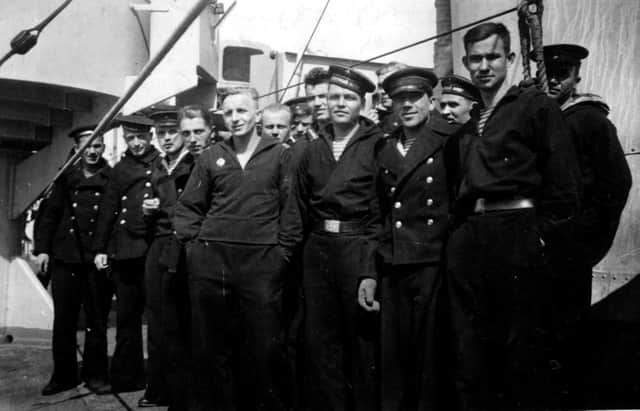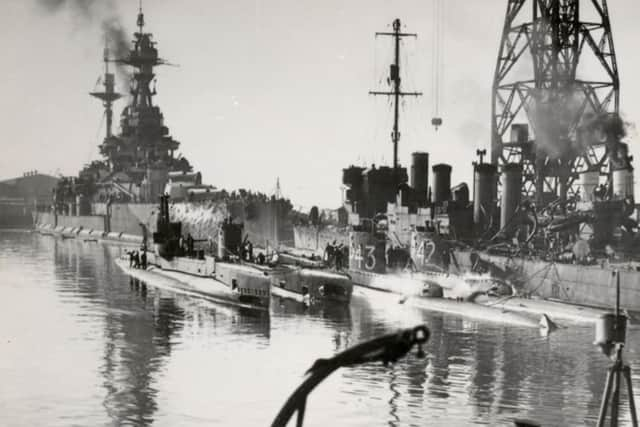The long summer when 2,300 Russian sailors anchored in the Firth of Forth


HM Dockyard Rosyth became nerve centre of the handover, where a fleet that included a British battleship, six destroyers and four submarines were refitted for their new owners, with training given on how to handle the vessels and new parts forged in the workshops there.
Accounts suggest tension underpinned the transfer, with Russians remaining armed with pistols at all times and dressed in full formal naval uniform, complete with medals. The British moaned that the Russians spent too long in the bathrooms, perhaps trying to recreate the conditions of their traditional banya steam bath.
Advertisement
Hide AdAdvertisement
Hide AdResearch by the V and W Destroyer Association, which supports surviving veterans who served in ships of the class, has helped to illuminate this forgotten episode of World War Two after they were contacted by the grandson of one of a Senior Lieutenant in the Russian Navy who was one of 23 Russians killed on the long journey to Scotland in a German torpedo attack off Norway’s Bear Island.


The convoy finally arrived in Scotland on May 6, 1944 and the operation in the Firth of Forth soon began.
Frank Donald, of Edinburgh, a retired Lieutenant Commander in the Royal Naval and a member of the association, said: “It was collaborative but the Russians were fairly on their guard,
"There was a certain amount of culture shock on both sides.
“The Officers wore medals with uniform, and pistols, at all times. Twenty Russian Officers were expected at Lunch on the Wardroom on the first day, and thirty four turned up. It was realised that fourteen had gone round again, and in future this was prevented by hiding their napkins and napkin rings after the first pass.
Advertisement
Hide AdAdvertisement
Hide Ad"There were also a difference of expectations regarding bathrooms. The British were surprised that when the Russians did use the bathrooms they occupied them for hours and totally filled them with steam. In fact the visitors were probably trying to reproduce the atmosphere of the traditional Russian Banya, though there is no record of them jumping overboard afterwards.”
The Russians were also “very suspicious” that items which they felt now belonged to them were being taken ashore, such as old Midshipmens Chests that were in poor repair.
The ships were loaned to the Russians after the capture of the Italian Navy, with Stalin demanding that a number of vessels be handed over to Russia in order to aid “our common fight against Germany”.
After Churchill finally relented, opting instead to hand over a British battleship given difficulties in moving an Italian vessel out of the Mediterranean, an extraordinary gathering of naval might took shape in Scottish waters.
Advertisement
Hide AdAdvertisement
Hide AdA group of interpreters was provided, whose duties included translating technical turnover information as well as the brass tallies on machinery controls into Russian.
Stalin accepted the old British Battleship Royal Sovereign – soon to be renamed Arkhangelsk – as well as the USS Milwaukee, an American cruiser that became known as Murmansk.
Six destroyers in total, including HMS St Albans and HMS Brighton, were also transferred, as well as four submarines.
A renaming ceremony was held in the Firth of Forth on May 31, which was attended by the Russian Ambassador and the Deputy First Sea Lord Admiral Kennedy-Purvis.
Advertisement
Hide AdAdvertisement
Hide AdMr Donald added: “Following the transfer, June and July were spent on familiarisation of the Russian crew and trials and workup exercises in the Firth of Forth.
"For security reasons, particularly with respect to details of state of the art radar aerials, the ship was anchored overnight well to seaward of the Dockyard. In mid July the Arkhangelsk moved to Scapa Flow for to continue workup, where she was joined by the destroyers.”
Then, the Arkhangelsk and her accompanying destoryers were picked up by an Arctic Convoy that that left Loch Ewe on August 15 with a ceremonial entry to the Russian Navy’s Northern Fleet made 10 days later after the convoy passed Norway’s Bear Island.
It was not the last that Scotland was to see of the warships, however, with the HMS Royal Sovereign/ Arkhangelsk remaining on loan to the Soviet Union until February 9, 1949.
Advertisement
Hide AdAdvertisement
Hide AdMr Donald added: “Then, she was handed back at Rosyth, and reverted to her original name before being sold for scrapping at Inverkeithing.”
A message from the Editor:Thank you for reading this story on our website. While I have your attention, I also have an important request to make of you.With the coronavirus lockdown having a major impact on many of our advertisers - and consequently the revenue we receive - we are more reliant than ever on you taking out a digital subscription.Subscribe to scotsman.com and enjoy unlimited access to Scottish news and information online and on our app. With a digital subscription, you can read more than 5 articles, see fewer ads, enjoy faster load times, and get access to exclusive newsletters and content. Visit https://www.scotsman.com/subscriptions now to sign up.
Our journalism costs money and we rely on advertising, print and digital revenues to help to support them. By supporting us, we are able to support you in providing trusted, fact-checked content for this website.
Joy Yates
Editorial Director
---------------------------------
Comment Guidelines
National World encourages reader discussion on our stories. User feedback, insights and back-and-forth exchanges add a rich layer of context to reporting. Please review our Community Guidelines before commenting.